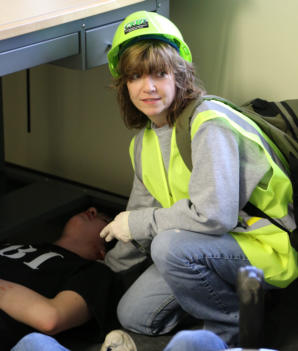










Frequently Asked Questions (FAQs)
What is CERT?
The Community Emergency Response Team (CERT) Program educates people about disaster preparedness for hazards that may impact their area and trains them in basic disaster response skills, such as fire safety, light search and rescue, team organization, and disaster medical operations. Using the training learned in the classroom and during exercises, CERT members can assist others in their neighborhood or workplace following an event when professional responders are not immediately available to help. CERT members also are encouraged to support emergency response agencies by taking a more active role in emergency preparedness projects in their community. The About Us section of this site gives you a complete description of CERT.How does CERT benefit the community?
People who complete CERT training have a better understanding of the potential threats to their home, workplace, and community and the tools to take smart steps in mitigating, or lessening, the effects of these hazards in all aspects of their lives. If a disaster occurs that overwhelms local response capability, CERT members can apply the training learned in the classroom and during exercises to give critical support to their family, loved ones, neighbors or associates in their immediate area until help arrives. When help does arrive, CERT members can provide useful information to responders and support their efforts, as directed, at the disaster site. Families prepared to meet their own needs and that of their neighbors during and after a disaster reduces the stress on the entire emergency response system. CERT members can also assist with non-emergency projects that improve the safety of the community. CERTs have been used to distribute and/or install smoke alarms, replace smoke alarm batteries in the home of elderly, distribute disaster education material, and provide services at special events, such as parades, sporting events, concerts and more.Is there a CERT near me?
Over 1100 communities and growing have listed their program on the CERT web site under the Directory of CERT Programs by State. You can check the State Directory to see if one is in your community. Check here for a listed of team in the State of Ohio: http://www.citizencorps.gov/cc/CertIndex.do?reportsForState&cert=&state=OHWhy take the CERT training?
Local government prepares for everyday emergencies. However, an emergency or disaster can overwhelm the community's immediate response capacity and capabilities. While adjacent jurisdictions, state and federal resources will activate to help when needed, there will be delays in emergency services. The primary reason for CERT training is to give people the decision-making, organizational, and practical skills to offer immediate assistance to family members, neighbors, and associates while waiting for help. While people will respond to others in need without the training, the goal of the CERT program is to help people do so effectively and efficiently without placing themselves in unnecessary danger. A success story about CERTs comes from events during the wildfires in Florida. The Edgewater CERT helped emergency management and the fire department personnel by assisting with evacuation; handling donations; preparing food for firefighters; and answering the phone while the professionals were fighting the fire. This is a great example of CERT members and response personnel working together for the benefit of the community. Locally, in 2012, the Westshore Regional CERT logged 536 hour watching downed power lines, serving as security at hospitality centers, and operating a Red Cross shelter.Who can take the training?
All U.S. citizens would benefit from the training, from 18 to 80+! Along with individuals and couples, community groups that would benefit include neighborhood watch groups, communities of faith, school staff, key employees, scouting organization, and other groups that come together regularly for a common purpose. CERT skills are useful in disaster and everyday life events.How do I take CERT training?
To become a CERT member, you will need to complete the FEMA CERT Basic Training course from a sponsoring agency such as an emergency management agency, fire department, or police department in the area where you live or work. Contact your local emergency manager and ask about the education and training opportunities available to you. Let this person know about your interest in CERT. What if I want to do more than just the basic training? CERT members can increase their knowledge and capabilities by attending classes provided by your local community and other community agencies on animal care, special needs concerns, donation management, community relations, shelter management, debris removal, utilities control, advanced first aid, Automatic External Defibrillator use, CPR skills, and others. Your sponsoring agency should maintain records of this training and call upon CERT members when these additional skills are needed in the community. CERT member can also use their skills to help the program flourish by volunteering to schedule events, produce a newsletter, perform administrative work, and take leadership positions.How do CERT members maintain their skills?
CERT members and the local sponsoring agency work together to maintain team skills and partnerships. Some response agencies have conducted joint exercises with CERTs and operate as they would during an actual disaster. Besides training CERT members, it is also important to educate members of response agencies in the community about CERTs, the team’s capabilities, and the roles in which they can serve during a major disaster. Local responders are encouraged to participate in classes as instructors and coaches and in local CERT activities. Understanding that CERTs may operate independently following a disaster, teams can practice this independence by taking some responsibility for their own training. Teams can design activities and exercises for themselves and with other teams. Some members can be rescuers, some victims, and some evaluators.Can someone under age 18 participate?
This is a local decision. Someone under 18 should be with a parent or have permission to attend. Some communities have reached out specifically to young people. Teen CERT training programs (http://www.fema.gov/community-emergency-response- teams/teen-community-emergency-response-team) continue to expand. CERT is a great way to address the community service requirements for high school students while providing them with useful skills. CERT also fits nicely with training given to Boy and Girl Scouts, Young Marines, and the Civil Air patrol.What if I have concerns about my age or physical
ability?
There are many tasks within a CERT for someone who wants to be involved and help. Following a disaster, CERT members are needed for documentation, comforting others, logistics, and many other support roles. Non-disaster related team activities may include keeping databases, developing a website, writing a newsletter, planning activities, assisting with special events, and organizing exercises and activities. During CERT classroom training, if one has a concern performing an action such as lifting, just let the instructor know. You can learn from watching. We would like everyone who wants to complete the training have the opportunity to participate and learn these lifesaving skills. CERT educates all citizens about local hazards and trains them in skills that are useful during disaster and life's everyday emergencies.What about liability?
During training, each sponsoring agency should brief its CERT members about their responsibilities as a CERT member and volunteer. All CERT members are required to register on the Ohio Responds database, which not only provides resource information to state emergency planners, but also provides additional liability coverage to members acting within their training. “Community Emergency Response Team (CERT) programs support post-disaster response and help ensure that CERT response efforts are as safe and effective as possible. CERT program activities can create risk and adverse consequences; however, perceptions about liability may be a larger barrier for CERT formation, activities and partnerships than is justified by reality. The purpose of the CERT Liability Guide is to offer information and suggested techniques to help CERT programs overcome this barrier. Those who will benefit from this information include local CERT programs, their sponsoring government agencies and legal advisors and CERT members themselves.” Click to download the CERT Liability Guide.










